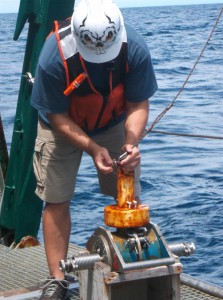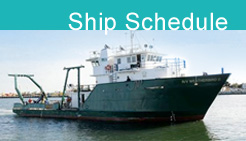Deep Sea Fish and Sediment Surveys in the Gulf
Saturday am
Posted by K.Bylsma, C-IMAGE , Teacher at Sea on Saturday am.
Last night’s water filtering was completed at 0200 – which is actually Saturday! Today’s CTD drop, though was scheduled for 0800, so prep time had to be completed by 0700. No one was up, so I watched the sunrise while the dolphins played around the bow of the boat. Right after that, I was assigned a new task. A contact of Heather’s needed to collect rain water at designated latitudes, so I was handed a small jar to take to the bow of the vessel. Standing in the rain, I had to hold the container at a 45degree angle collecting rain water for about 30 minutes. The temperature was certainly satisfying and the natural shower was refreshing. This sampling will be continued at other latitudes.
Next, it was time to set up the tests for water samples and then launch the Bongo nets. Teachers: Lots of math this time around ( not that the measuring and chemistry components have not also had math)( See Heather’s calculations)
1 knot (kt) = 1.15077945 miles per hour (mph)
While on this trip, we have been changing our speed relative to whatever we’re towing at the time. Normal travel speed varies, but speed is 8 kts. Towing the bongo nets and the Shipek requires a speed of 1.5-2 kts , the CTD requires a 1.5-2 kts travel speed and the SIPPER requires a travel speed of 3 kts.
Teachers: Allow students to 1/ convert knots to miles per hour ( probably a more familiar term to them. 2/ Encourage discussion with the students involving the engine system in each of the towing incidences- without additional tow ( only passengers), towing the Bongo nets, towing the SHIPEK, and towing the SIPPER ( #3 was #250-300 , while #4 was #450.
 The Shipek is used to collect soil samples. I had wanted to witness this activity. Jonelle is collecting these samples to test for toxicity ( on the vessel) and followup testing for the next weeks in the lab, since these samples require baking them to remove the water. This will preserve the biological material for analyzation. The Shipek is different from coring samples due to depth. The Shipek is a “ trap” device that is activated when it hits the floor and then “scoops” a sample of earth into the trap. The winch then raises the SHIPEK back to the deck where the soils are released and tested for toxicity here on the vessel, but also back at the lab.
The Shipek is used to collect soil samples. I had wanted to witness this activity. Jonelle is collecting these samples to test for toxicity ( on the vessel) and followup testing for the next weeks in the lab, since these samples require baking them to remove the water. This will preserve the biological material for analyzation. The Shipek is different from coring samples due to depth. The Shipek is a “ trap” device that is activated when it hits the floor and then “scoops” a sample of earth into the trap. The winch then raises the SHIPEK back to the deck where the soils are released and tested for toxicity here on the vessel, but also back at the lab.



1- attached to a winch and closed, 2/ comes apart when the winch returns to deck, and finally, 3/ the sediment tray that is removed for testing.
More on the actual toxicity results later.
| Print article | This entry was posted by greely on August 15, 2013 at 10:30 pm, and is filed under Oceanic Updates. Follow any responses to this post through RSS 2.0. You can leave a response or trackback from your own site. |



